Fabrication of Humidity-Resistant Optical Fiber Sensor for Ammonia Sensing Using Diazo Resin-Photocrosslinked Films with a Porphyrin-Polystyrene Binary Mixture
Abstract
:1. Introduction
2. Materials and Methods
2.1. Materials
2.2. Preparation of Optical Fiber Sensor
2.3. Experimental Setup and Sensing Performance
2.4. Film Characterization
3. Results and Discussion
3.1. Strategy for Sensitive and Reproducible Sensor Fabrication
3.2. Optical Features of Covalently Attached DAR/TSPP+PSS Multilayers
3.3. Sensor Responses to Ammonia
3.4. Optimization of the Content of PSS Employed in the Sensor Film
3.5. Sensitivity and Selectivity of the PSS-Containing Sensor Films
3.6. Stability and Reproducibility of the Sensing System
3.7. Film Structure and Morphology
3.8. Sensing Mechanism
4. Conclusions
Supplementary Materials
Author Contributions
Funding
Institutional Review Board Statement
Informed Consent Statement
Data Availability Statement
Acknowledgments
Conflicts of Interest
References
- Pospíšilová, M.; Kuncová, G.; Trögl, J. Fiber-optic chemical sensors and fiber-optic bio-sensors. Sensors 2015, 15, 25208–25259. [Google Scholar] [CrossRef]
- Liu, L.; Marques, L.; Correia, R.; Morgan, S.P.; Lee, S.-W.; Tighe, P.; Fairclough, L.; Korposh, S. Highly sensitive label-free antibody detection using a long period fibre grating sensor. Sens. Actuators B Chem. 2018, 271, 24–32. [Google Scholar] [CrossRef]
- Kharaz, A.; Jones, B.E. A distributed optical-fibre sensing system for multi-point humidity measurement. Sens. Actuators A Phys. 1995, 47, 491–493. [Google Scholar] [CrossRef]
- Rajamani, A.S.; Murugan, D.; Sai, V.V.R. Plastic fiber optic sensor for continuous liquid level monitoring. Sens. Actuators A Phys. 2019, 296, 192–199. [Google Scholar] [CrossRef]
- Cennamo, N.; Massarotti, D.; Conte, L.; Zeni, L. Low cost sensors based on SPR in a plastic optical fiber for biosensor implementation. Sensors 2011, 11, 11752–11760. [Google Scholar] [CrossRef]
- Lomer, M.; Quintela, A.; López-Amo, M.; Zubia, J.; López-Higuera, J.M. A quasi-distributed level sensor based on a bent side-polished plastic optical fibre cable. Meas. Sci. Technol. 2007, 18, 2261–2267. [Google Scholar] [CrossRef]
- Feng, D.-J.; Zhang, M.-S.; Liu, G.; Liu, X.-L.; Jia, D.-F. D-Shaped plastic optical fiber sensor for testing refractive index. IEEE Sens. J. 2014, 14, 1673–1676. [Google Scholar]
- Satija, J.; Punjabi, N.S.; Sai, V.V.R. Optimal design for U-bent fiber-optic LSPR sensor probes. Plasmonics 2014, 9, 251–260. [Google Scholar] [CrossRef]
- Timmer, B.; Olthuis, W.; Berg, A. Ammonia sensors and their applications—A review. Sens. Actuators B Chem. 2005, 107, 666–677. [Google Scholar] [CrossRef]
- Occupational Safety and Health Administration. Available online: https://www.osha.gov/laws-regs/regulations/standardnumber/1910/1910.1000TABLEZ1 (accessed on 8 May 2021).
- Shipman, M.A.; Symes, M.D. Recent progress towards the electro-synthesis of ammonia from sustainable resources. Catal. Today 2017, 286, 57–68. [Google Scholar] [CrossRef] [Green Version]
- Liu, L.; Fei, T.; Guan, X.; Zhao, H.; Zhang, T. Humidity-activated ammonia sensor with excellent selectivity for exhaled breath analysis. Sens. Actuators B Chem. 2021, 334, 129625. [Google Scholar] [CrossRef]
- Shahmoradi, A.; Hosseini, A.; Akbarinejad, A.; Alizadeh, N. Noninvasive detection of ammonia in the breath of hemodialysis patients using a highly sensitive ammonia sensor based on a polypyrrole/sulfonated graphene nanocomposite. Anal. Chem. 2021, 93, 6706–6714. [Google Scholar] [CrossRef]
- Davies, S.; Spanel, P.; Smith, D. Quantitative analysis of ammonia on the breath of patients in end-stage renal failure. Kidney Int. 1997, 52, 223–228. [Google Scholar] [CrossRef] [PubMed] [Green Version]
- Narasimhan, L.R.; Goodman, W.; Patel, C.K.N. Correlation of breath ammonia with blood urea nitrogen and creatinine during hemodialysis. Proc. Natl. Acad. Sci. USA 2001, 98, 4617–4621. [Google Scholar] [CrossRef] [PubMed] [Green Version]
- Ong, J.P.; Aggarwal, A.; Krieger, D.; Easley, K.A.; Karafa, M.T.; Lente, F.; Arroliga, A.C.; Mullen, K.D. Correlation between ammonia levels and the severity of hepatic encephalopathy. Am. J. Med. 2003, 114, 188–193. [Google Scholar] [CrossRef]
- Kusters, J.G.; Vliet, A.H.M.; Kuipers, E.J. Pathogenesis of helicobacter pylori infection. Clin. Microbiol. Rev. 2006, 19, 449–490. [Google Scholar] [CrossRef] [Green Version]
- Bannov, A.G.; Popov, M.V.; Brester, A.E.; Kurmashov, P.B. Recent advances in ammonia gas sensors based on carbon nanomaterials. Micromachines 2021, 12, 186. [Google Scholar] [CrossRef]
- Rodríguez, A.; Zamarreño, C.; Matías, I.; Arregui, F.; Cruz, R.; May-Arrioja, D. A fiber optic ammonia sensor using a universal pH indicator. Sensors 2014, 14, 4060–4073. [Google Scholar] [CrossRef] [PubMed]
- Korposh, S.; Kodaira, S.; Lee, S.-W.; Batty, W.J.; James, S.W. Nano-assembled thin film gas sensor: II. An intrinsic high sensitive fibre optic sensor for ammonia detection. Sens. Mater. 2009, 21, 179–189. [Google Scholar] [CrossRef] [Green Version]
- Korposh, S.; Selyanchyn, R.; Yasukochi, W.; Lee, S.-W.; James, S.W.; Tatam, R.P. Optical fibre long period grating with a nanoporous coating formed from silica nanoparticles for ammonia sensing in water. Mater. Chem. Phys. 2012, 133, 784–792. [Google Scholar] [CrossRef]
- Korposh, S.; Kodaira, S.; Selyanchyn, R.; Ledezma, F.H.; James, S.W.; Lee, S.-W. Porphyrin-nanoassembled fiber-optic gas sensor fabrication: Optimization of parameters for sensitive ammonia gas detection. Opt. Laser Technol. 2018, 101, 1–10. [Google Scholar] [CrossRef] [Green Version]
- Sun, J.; Wu, T.; Liu, F.; Wang, Z.; Zhang, X.; Shen, J. Covalently attached multilayer assemblies by sequential adsorption of polycationic diazo-resins and polyanionic poly(acrylic acid). Langmuir 2000, 16, 4620–4624. [Google Scholar] [CrossRef]
- Sun, J.; Wu, T.; Zou, B.; Zhang, X.; Shen, J. Stable entrapment of small molecules bearing sulfonate groups in multilayer assemblies. Langmuir 2001, 17, 4035–4041. [Google Scholar] [CrossRef]
- Cao, W.X.; Ye, S.J.; Cao, S.G.; Zhao, C. Novel polyelectrolyte complexes based on diazo-resins. Macromol. Rapid Commun. 1997, 18, 983–989. [Google Scholar] [CrossRef]
- Zhao, C.; Chen, J.Y.; Cao, W.X. Synthesis and characterization of diphenylamine diazonium salts and diazoresins. Angew. Makromol. Chem. 1998, 259, 77–82. [Google Scholar] [CrossRef]
- Wang, T.; Korposh, S.; James, S.W.; Tatam, R.P.; Lee, S.-W. Optical fiber long period grating sensor with a polyelectrolyte alternate thin film for gas sensing of amine odors. Sens. Actuators B Chem. 2013, 185, 117–124. [Google Scholar] [CrossRef]
- Wang, T.; Yasukochi, W.; Korposh, S.; James, S.W.; Tatam, R.P.; Lee, S.-W. A long period grating optical fiber sensor with nano-assembled porphyrin layers for detecting ammonia gas. Sens. Actuators B Chem. 2016, 228, 573–580. [Google Scholar] [CrossRef]
- Takagi, S.; Eguchi, M.; Tryk, D.A.; Inoue, H. Porphyrin photochemistry in inorganic/organic hybrid materials: Clays, layered semiconductors, nanotubes, and mesoporous materials. J. Photochem. Photobiol. C 2006, 7, 104–126. [Google Scholar] [CrossRef]
- Zha, S.; Li, X.; Yang, M.; Sun, C. Fabrication and characterization of covalently attached multilayer films containing iron phthalocyanine and diazo-resins. J. Mater. Chem. 2004, 14, 840–844. [Google Scholar] [CrossRef]
- Gregory van Patten, P.; Shreve, A.P.; Donohoe, R.J. Structural and photophysical properties of water-soluble porphyrin associated with polycations in solution and electrostatically-assembled ultrathin films. J. Phys. Chem. B 2000, 10, 5986–5992. [Google Scholar] [CrossRef]
- John, A.R.; William, B.B.; Theodore, K.S. Organic Solvents Physical Properties and Methods of Purification: Techniques of Chemistry, 4th ed.; Wiley: New York, NY, USA, 1986. [Google Scholar]
- Lee, S.-W.; Takahara, N.; Korposh, S.; Yang, D.-H.; Toko, K.; Kunitake, T. Nano-assembled thin film gas sensor. III. Sensitive detection of amine odors using TiO2/polyacrylic acid ultrathin film QCM sensors. Anal. Chem. 2010, 82, 2228–2236. [Google Scholar] [CrossRef]
- Smith, A.R.; Ruggles, J.L.; Yu, A.; Gentle, I.R. Multilayer nanostructured porphyrin arrays constructed by layer-by-layer self-assembly. Langmuir 2009, 25, 9873–9878. [Google Scholar] [CrossRef] [PubMed]
- Liu, L.; Morgan, S.P.; Correia, R.; Lee, S.-W.; Korposh, S. Multi-parameter optical fiber sensing of gaseous ammonia and carbon dioxide. J. Light. Technol. 2020, 38, 2037–2045. [Google Scholar] [CrossRef]
- Cao, W.; Duan, Y. Optical fiber-based evanescent ammonia sensor. Sens. Actuators B Chem. 2005, 110, 252–259. [Google Scholar] [CrossRef]
- Khalaf, A.L.; Mohamad, F.S.; Abdul Rahman, N.; Lim, H.N.; Paiman, S.; Yusof, N.A.; Mahdi, M.A.; Yaacob, M.H. Room temperature ammonia sensor using side-polished optical fiber coated with graphene/polyaniline nanocomposite. Opt. Mater. Exp. 2017, 7, 1858–1870. [Google Scholar] [CrossRef]
- Jarzebinska, R.; Korposh, S.; James, S.; Batty, W.; Tatam, R.; Lee, S.-W. Optical gas sensor fabrication based on porphyrin-anchored electrostatic self-Assembly onto tapered optical fibers. Anal. Lett. 2012, 45, 1297–1309. [Google Scholar] [CrossRef] [Green Version]
- Bielecki, Z.; Stacewicz, T.; Smulko, J.; Wojtas, J. Ammonia gas sensors: Comparison of solid-state and optical methods. Appl. Sci. 2020, 10, 5111. [Google Scholar] [CrossRef]
- Shiba, S.; Yamada, K.; Matsuguchi, M. Humidity-resistive optical NO gas sensor devices based on cobalt tetraphenylporphyrin dispersed in hydrophobic polymer matrix. Sensors 2020, 20, 1295. [Google Scholar] [CrossRef] [Green Version]
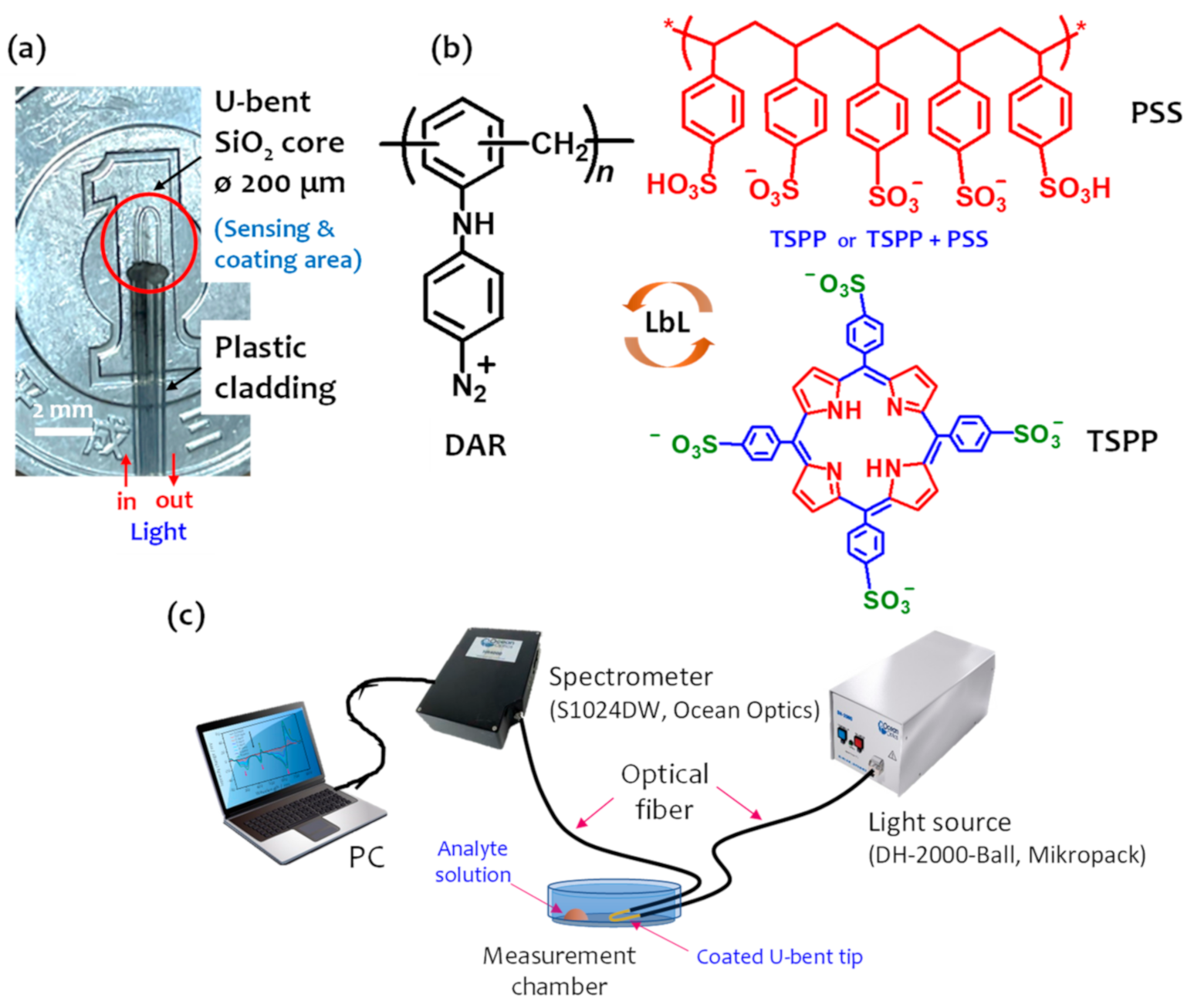

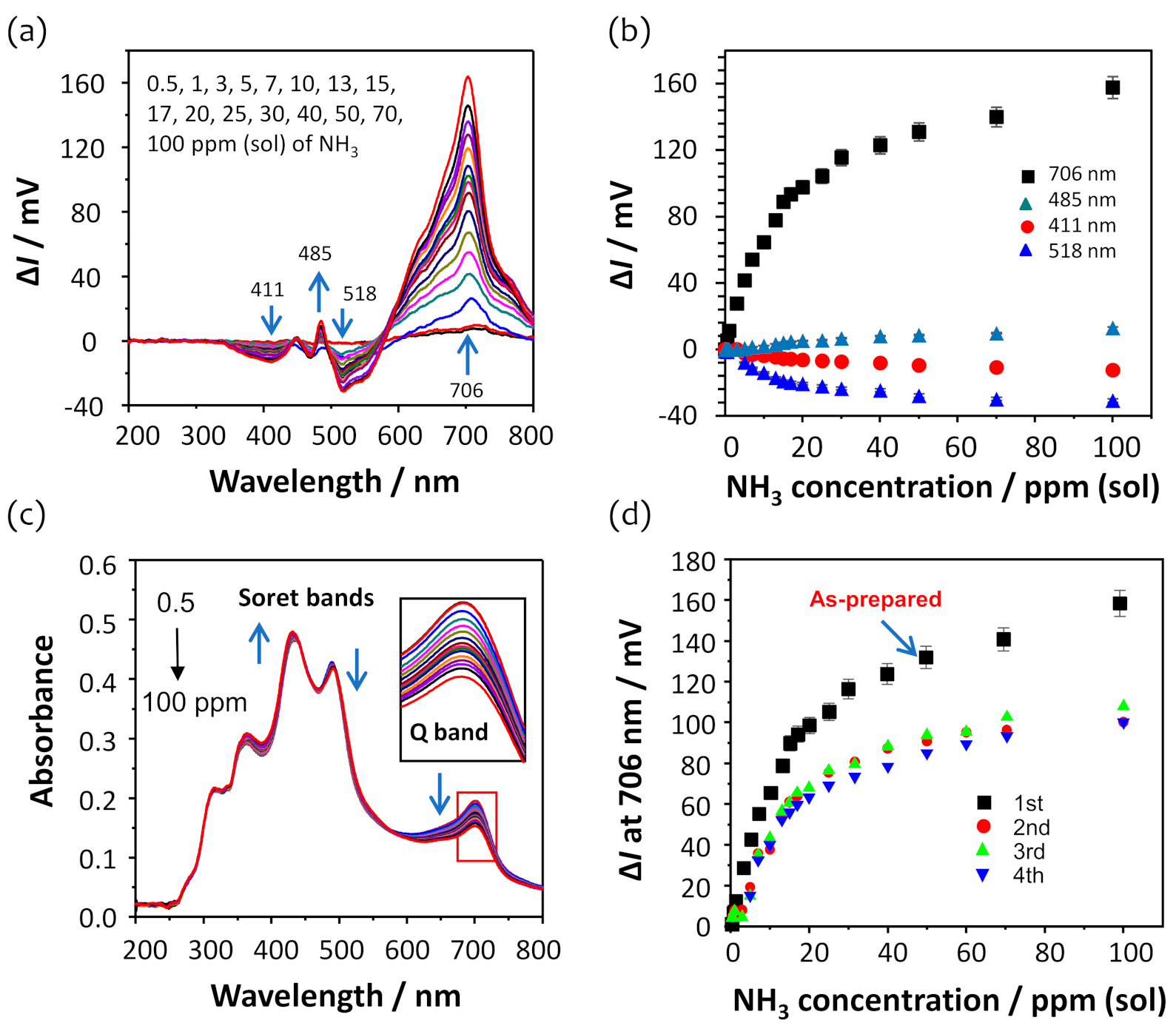
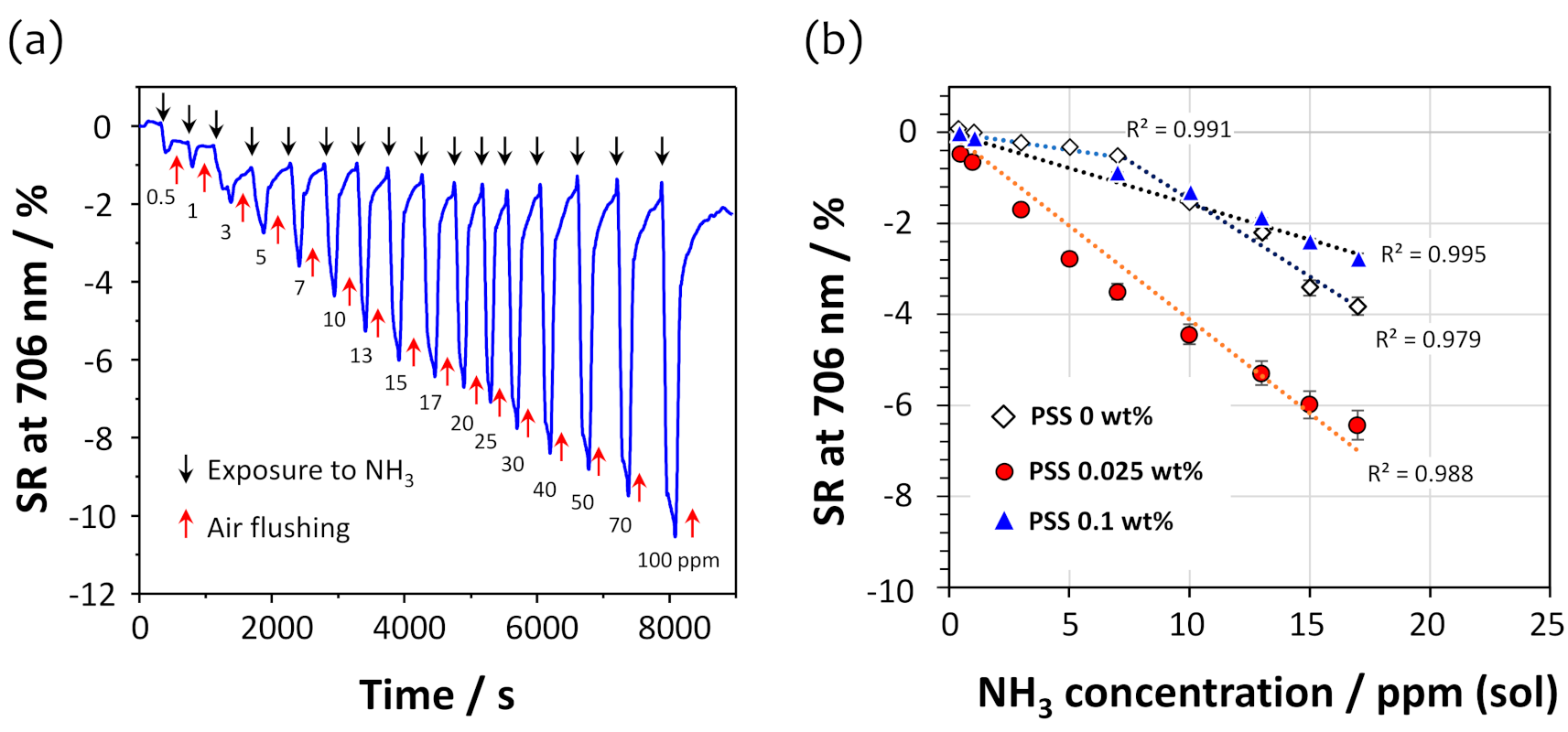
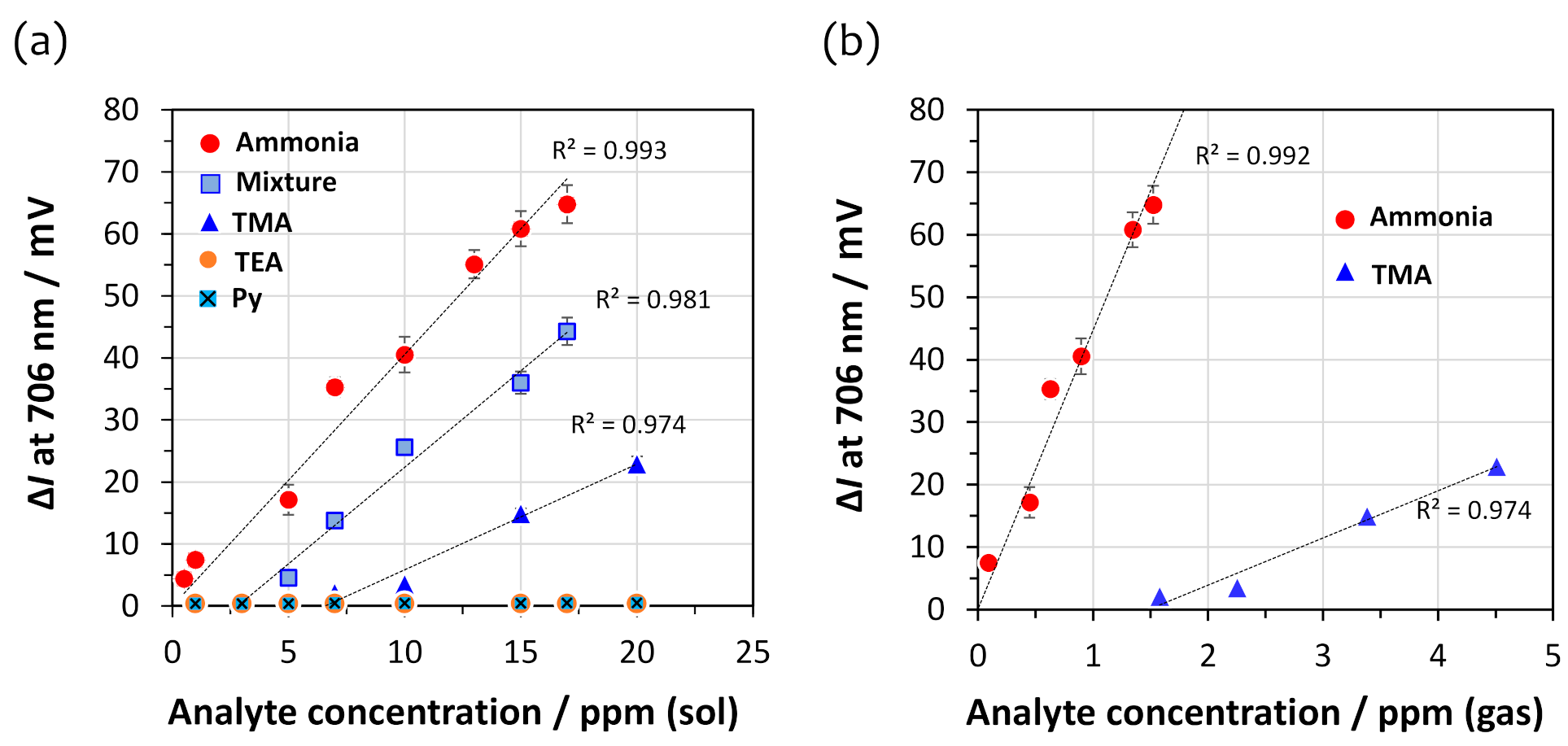
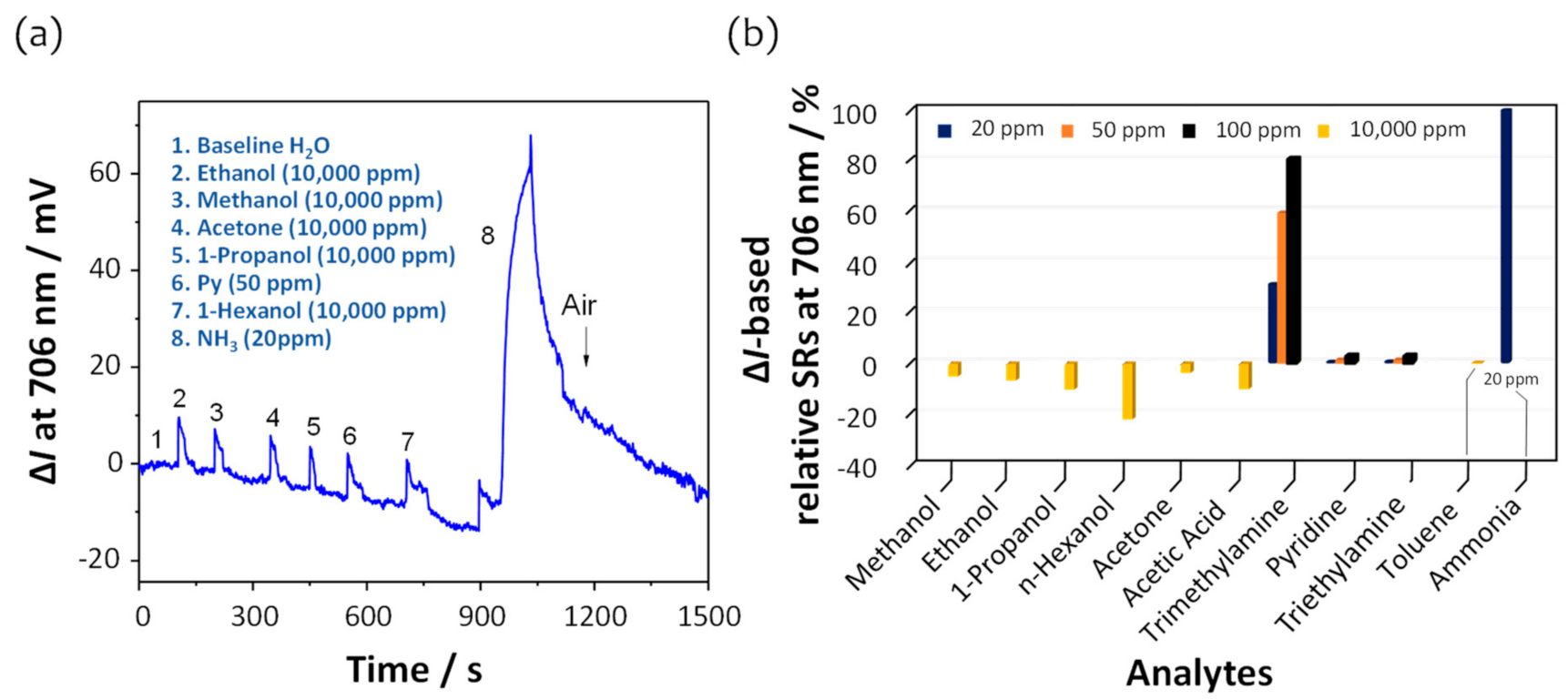
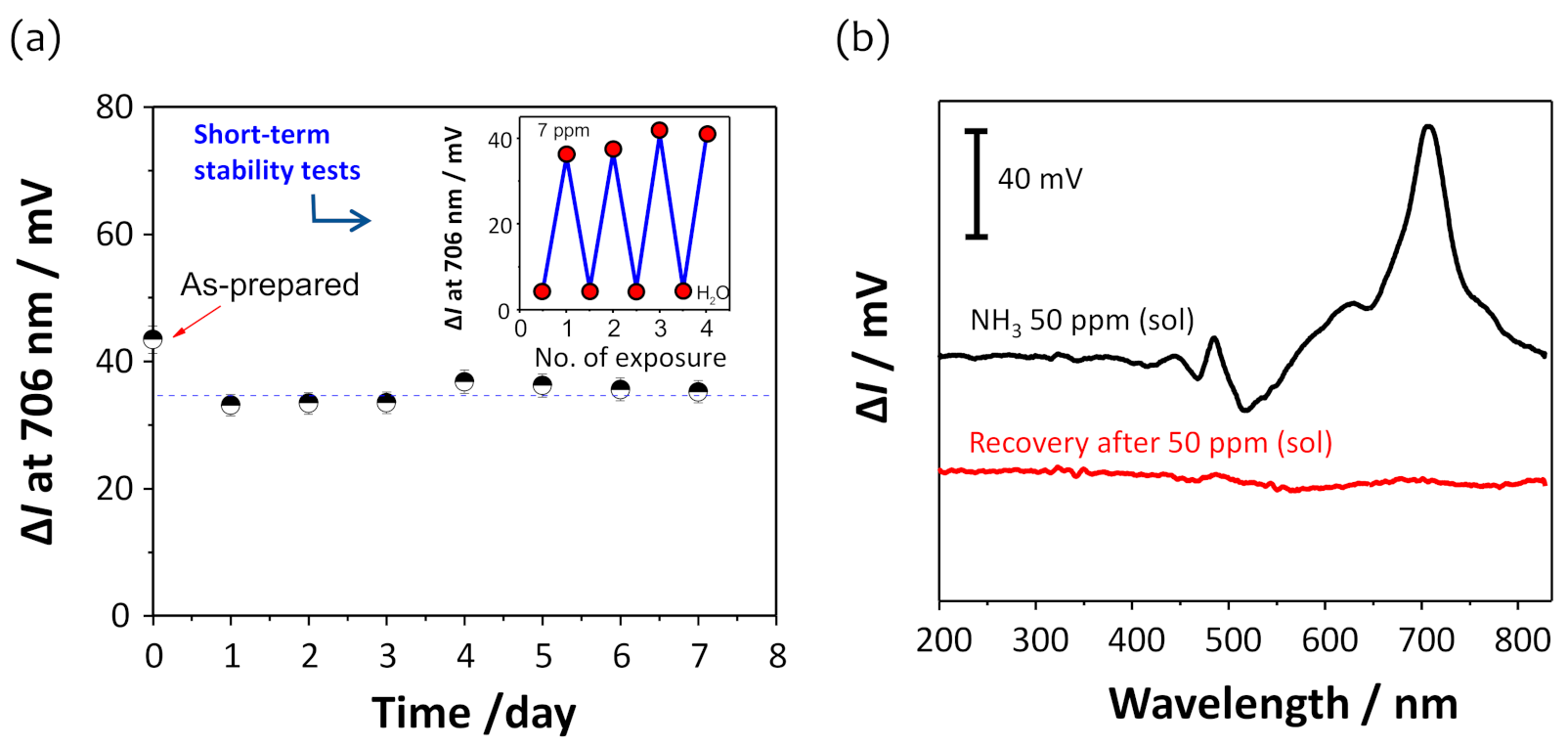

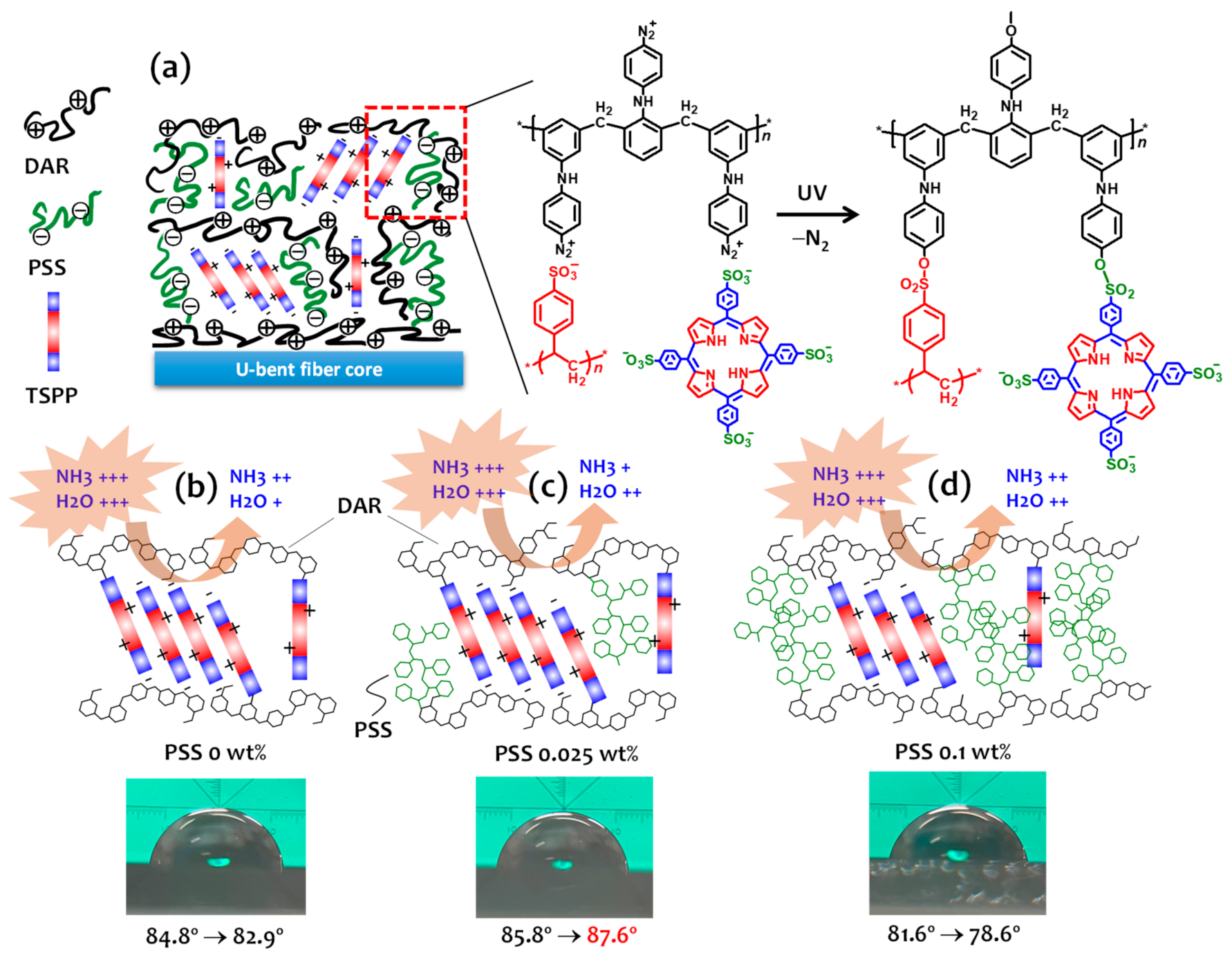
| Film Name | Sensitivity (Slope) a, % ppm−1 (R2) | Response Time b, s | Recovery Time, s | Linear Range b, ppm (sol) | LOD (sol) c, ppm (sol) |
|---|---|---|---|---|---|
| DAR/TSPP+PSS (0 wt%) | 0.08 (0.991) 0.34 (0.979) | 100 | 180 | 0–7 7–17 | 1.25 2.81 |
| DAR/TSPP+PSS (0.025 wt%) | 0.41 (0.988) | 30 | 30 | 0–17 | 0.23 |
| DAR/TSPP+PSS (0.1 wt%) | 0.16 (0.997) | 45 | 40 | 0–20 | 0.61 |
| Analyte | Sensitivity (sol) a, mV ppm−1 (R2) | LOD (sol) d, ppm | Sensitivity (gas), mV ppm−1(R2) | LOD (gas) d, ppm |
|---|---|---|---|---|
| Ammonia | 4.05 (0.993) b | 0.31 | 44.7 (0.992) | 2.85 × 10−2 |
| TMA | 1.73 (0.974) c | 7.21 | 7.56 (0.974) | 1.65 |
| Mixture | 3.11 (0.974) c | 3.23 | NA | NA |
| Sensing Platform | Sensing Material | Fabrication Method | LOD (ppm) | Response Time | Recovery Time | Humidity Range |
|---|---|---|---|---|---|---|
| U-bent optical fiber (this study) | DAR/TSPP+PSS | Crosslinked LbL | 0.03 | 30 s (r.t.) | 30 s (r.t.) | 85% |
| Fiber tip [35] | TSPP | Sol–gel | 0.15 | 83 s | NA | <70% |
| U-bent optical fiber [36] | Bromocresol purple | Dip coating sol–gel | 10 (55.5 °C) | 5 min (r.t.) 10 s (55.5 °C) | 20 min (r.t.) 10 min (55.5 °C) | NA |
| Side polished fiber [37] | Graphene/polyaniline | Chemical in-situ polymerization | 22.5 | 112 s | 185 s | NA |
| Linear optical fiber [22] | TSPP/PDDA | LbL | 3 | 96 s | 192 s | NA |
| Fiber optic grating [28] | TSPP/PDDA | LbL | 0.67 | NA | NA | NA |
| Tapered fiber [38] | TSPP/PAH * | LbL | 2 | 100 s | 240 s | NA |
Publisher’s Note: MDPI stays neutral with regard to jurisdictional claims in published maps and institutional affiliations. |
© 2021 by the authors. Licensee MDPI, Basel, Switzerland. This article is an open access article distributed under the terms and conditions of the Creative Commons Attribution (CC BY) license (https://creativecommons.org/licenses/by/4.0/).
Share and Cite
Ahmed, S.; Park, Y.; Okuda, H.; Ono, S.; Korposh, S.; Lee, S.-W. Fabrication of Humidity-Resistant Optical Fiber Sensor for Ammonia Sensing Using Diazo Resin-Photocrosslinked Films with a Porphyrin-Polystyrene Binary Mixture. Sensors 2021, 21, 6176. https://doi.org/10.3390/s21186176
Ahmed S, Park Y, Okuda H, Ono S, Korposh S, Lee S-W. Fabrication of Humidity-Resistant Optical Fiber Sensor for Ammonia Sensing Using Diazo Resin-Photocrosslinked Films with a Porphyrin-Polystyrene Binary Mixture. Sensors. 2021; 21(18):6176. https://doi.org/10.3390/s21186176
Chicago/Turabian StyleAhmed, Soad, Yeawon Park, Hirofumi Okuda, Shoichiro Ono, Sergiy Korposh, and Seung-Woo Lee. 2021. "Fabrication of Humidity-Resistant Optical Fiber Sensor for Ammonia Sensing Using Diazo Resin-Photocrosslinked Films with a Porphyrin-Polystyrene Binary Mixture" Sensors 21, no. 18: 6176. https://doi.org/10.3390/s21186176
APA StyleAhmed, S., Park, Y., Okuda, H., Ono, S., Korposh, S., & Lee, S.-W. (2021). Fabrication of Humidity-Resistant Optical Fiber Sensor for Ammonia Sensing Using Diazo Resin-Photocrosslinked Films with a Porphyrin-Polystyrene Binary Mixture. Sensors, 21(18), 6176. https://doi.org/10.3390/s21186176








